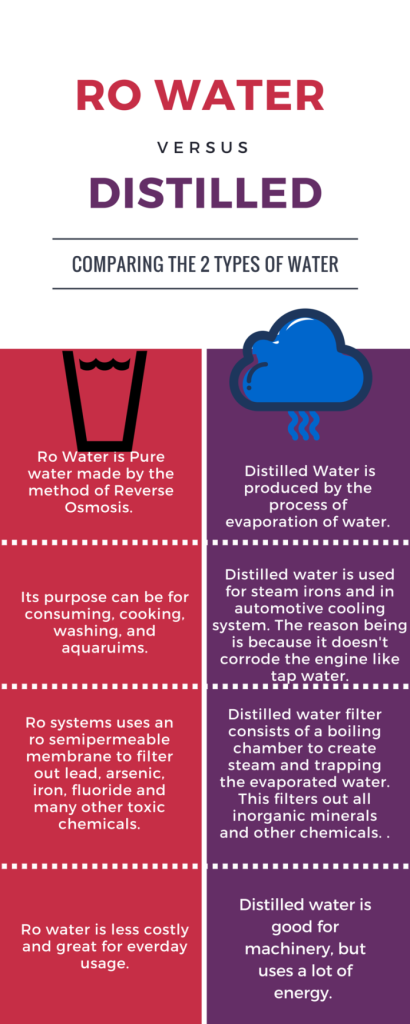Reverse osmosis and distilled water are both popular choices for clean drinking water. When comparing the two, it’s essential to consider the key features. Reverse osmosis removes impurities through a semipermeable membrane, eliminating contaminants like bacteria and chemicals. On the other hand, distilled water is created by vaporizing and condensing water, leaving behind impurities.
While both methods produce clean water, reverse osmosis more efficiently removes a broader range of contaminants. It’s important to note that reverse osmosis systems usually require professional installation, whereas distilled water can be easily obtained through distillation machines or store-bought. In summary, reverse osmosis provides a higher level of water purity compared to distilled water.
Comparing Reverse Osmosis vs Distilled Water
You may have encountered reverse osmosis and distilled water when choosing the right type of water for your needs. Both methods are used to purify water and remove impurities, but they differ in how they achieve this goal. In this article, we will compare reverse osmosis and distilled water, exploring their key features, user experience, pros and cons, price comparison, and ultimately determine which is better suited for different applications.
Overview of Reverse Osmosis
Reverse osmosis is a water purification process that removes contaminants from water by using pressure to force water molecules through a semipermeable membrane. This method is commonly used in residential and commercial settings to improve the taste and quality of drinking water.
Reverse osmosis systems typically consist of a pre-filter, a semipermeable membrane, and a post-filter. The pre-filter removes larger particles and sediments, while the semipermeable membrane filters out dissolved solids and contaminants such as salt, lead, and chlorine. The post-filter is the final step to ensure the water is clean and ready for consumption.
Reverse osmosis removes many impurities from water, resulting in purified water that is free from contaminants and has a crisp, clean taste. It is an effective method for improving tap water quality and can be used for drinking, cooking, and other household applications.
Overview of Distilled Water
Distilled water is created through distillation, which involves boiling water and collecting the steam, then condensing it into liquid. This method effectively removes impurities, minerals, and other substances from the water.
Distillation works by heating the water to create steam, which is then collected and cooled. The condensation process separates the water from any impurities, resulting in pure water free from most contaminants.
Distilled water is commonly used in medical and laboratory settings and for home appliances like steam irons and humidifiers. It is also a popular choice for car batteries and solar panels, as it does not contain minerals that could cause corrosion.
Key Features Compared
Water Purity
Regarding water purity, reverse osmosis and distilled water are effective at removing impurities and contaminants. However, reverse osmosis is more efficient at removing dissolved solids and contaminants, including bacteria and viruses, due to its use of a semipermeable membrane.
On the other hand, distilled water is excellent at removing minerals, chemicals, and heavy metals from the water. It is often considered the purest form of water, lacking impurities or dissolved solids.
Taste and Odor
Regarding taste and odour, reverse osmosis and distilled water provide clean and refreshing water. However, some people may notice a difference in taste between the two. Distilled water tends to have a flat taste since it lacks minerals, while reverse osmosis water may have a slightly sweeter taste due to some minerals.
Maintenance and Filter Replacement
In terms of maintenance, reverse osmosis systems require regular filter replacement to maintain optimal performance. The pre-filter and post-filter need to be replaced every 6 to 12 months, while the semipermeable membrane typically lasts 2 to 3 years. This regular maintenance ensures that the system continues to provide clean and purified water.
Distillation systems also require maintenance, mainly cleaning the boiling chamber and replacing any filters or components. However, maintenance frequency is typically lower than in reverse osmosis systems.
User Experience
When it comes to user experience, both reverse osmosis and distilled water have their advantages. Reverse osmosis systems are often installed under the sink and provide a convenient source of purified water for drinking and cooking. They are easy to use and maintain, and the filters are readily available.
Distilled water, on the other hand, may require a separate distillation unit to produce the water. This additional equipment may take up space and require regular cleaning and maintenance. However, producing distilled water is straightforward once the system is set up.

Pros and Cons
Reverse Osmosis
Pros:
- Effectively removes a wide range of impurities and contaminants
- Improves the taste and quality of tap water
- Convenient installation and easy to use
Cons:
- Requires regular filter replacement and maintenance
- Wastes some water during the purification process
- This may result in a higher upfront cost compared to other filtration methods
Distilled Water
Pros:
- Produces the purest form of water, free from impurities and minerals
- Used in various industries and applications
- Does not cause corrosion in appliances or equipment
Cons:
- Requires a separate distillation unit for production
- It may have a slightly flat taste due to the absence of minerals
- Requires regular cleaning and maintenance
Price Comparison
When it comes to price, reverse osmosis systems are generally more affordable compared to distillation units. The cost of a reverse osmosis system can vary depending on the brand, features, and installation requirements. On average, a reverse osmosis system can range from $200 to $600.
Distillation units, however, tend to be more expensive due to the additional equipment required. Depending on the capacity and features, a distillation unit can range from $300 to $1,000 or more. However, it’s essential to consider each option’s long-term cost and benefits.
Which is Better? Reverse Osmosis vs Distilled Water
The decision between reverse osmosis and distilled water depends on your needs and preferences. Consider factors such as the level of purity desired, taste preferences, maintenance requirements, and budget. Both methods provide clean and purified water and can enhance your overall water consumption experience.
- Reverse osmosis is better for those seeking a convenient and affordable solution for improving tap water quality.
- Distilled water is the better choice for those requiring the purest form of water, free from impurities and minerals.
- The final decision should be based on individual needs, taste preferences, and budget.
If you are looking for a convenient and affordable solution for improving the taste and quality of your tap water, reverse osmosis systems are an excellent choice. They effectively remove many impurities and contaminants, providing clean and refreshing water for drinking and cooking.
On the other hand, distilled water is the way to go if you require the purest form of water, free from impurities and minerals. It is commonly used in medical and laboratory settings and is suitable for various industrial applications.
Is Distilled or Reverse Osmosis Water Better?
In conclusion, reverse osmosis and distilled water have advantages and disadvantages regarding water purification. Reverse osmosis effectively removes many contaminants and impurities, while distilled water eliminates nearly all impurities, including minerals.
The choice between reverse osmosis and distilled water ultimately depends on your needs and preferences. If you are mainly concerned about removing contaminants from your drinking water, reverse osmosis may be the better option. However, distilled water may be more suitable if you are looking for the purest form of water without any minerals. It is essential to consider factors such as cost, maintenance, and the level of purity required before making a decision.

Hey there, folks! I’m Sakib, the guy who runs waterfilterhub.com. I’ve had a passion for pure water since I was a kid. I’ve always known that staying hydrated is crucial, but I also understood that the quality of the water matters just as much as how much you drink. So, I decided to embark on a mission to uncover the secrets of water filtration.